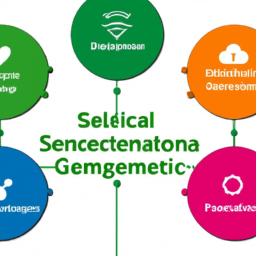Are you ready to take your career to the next level?
Get ready to embark on the ultimate Six Sigma Green Belt study plan that guarantees success.
This article will guide you through the process, helping you understand the Six Sigma methodology and develop essential tools and techniques.
With a focus on data analysis skills and process improvement projects, you’ll be well-equipped to ace the final exam.
Get ready to elevate your skills and achieve your professional goals like never before.
Key Takeaways
- Understanding key concepts and tools is essential to grasp the Six Sigma Methodology.
- Green Belts play a vital role in problem identification and solving within an organization.
- Developing data analysis skills is crucial for Green Belts to effectively utilize tools like root cause analysis and statistical process control.
- Effective project management skills, change management, and root cause analysis are important for implementing process improvement projects.
Understanding the Six Sigma Methodology
To understand the Six Sigma Methodology, you’ll need to familiarize yourself with its key concepts and tools.
The history of Six Sigma dates back to the 1980s when it was first introduced by Motorola. It gained popularity in the 1990s when General Electric adopted it as a core business strategy.
Six Sigma aims to improve business processes by reducing defects and variations to achieve near-perfect quality. By implementing Six Sigma, organizations can experience numerous benefits such as increased customer satisfaction, improved efficiency, reduced costs, and enhanced profitability.
Some of the specific advantages include improved product quality, streamlined operations, and better decision-making based on data-driven analysis.
Now, let’s move on to the essential tools and techniques for Green Belts, which are vital for successful implementation of Six Sigma.
Essential Tools and Techniques for Green Belts
The essential tools and techniques for green belts are crucial for achieving success in the Six Sigma methodology. As a green belt, you will play a vital role in identifying and solving problems within your organization. Two key tools that you will utilize are root cause analysis and statistical process control.
Root cause analysis is a systematic approach used to identify the underlying causes of a problem. By analyzing data and asking the right questions, you can uncover the root cause and develop effective solutions.
Statistical process control involves using statistical methods to monitor and control a process. This helps ensure that the process is stable and within control limits. By collecting data and analyzing it using control charts, you can identify any variations or trends that may impact the quality of the process.
Incorporating these tools and techniques into your Six Sigma practices will enhance your problem-solving abilities and enable you to drive process improvements.
| Tools | Techniques |
|---|---|
| Root Cause Analysis | Statistical Process Control |
| Data Collection | Control Charts |
| Pareto Analysis | Process Mapping |
| Fishbone Diagram | Regression Analysis |
| 5 Whys | Hypothesis Testing |
Developing Data Analysis Skills
Developing data analysis skills is essential for you as a green belt to effectively utilize tools and techniques like root cause analysis and statistical process control. To become proficient in analyzing data, you should focus on learning data visualization techniques and statistical software applications.
Data visualization techniques help you present complex data in a visual format, making it easier to identify patterns and trends. Statistical software applications, on the other hand, enable you to perform advanced data analysis and generate accurate statistical models.
Implementing Process Improvement Projects
Implementing process improvement projects requires effective project management skills. This includes planning, organizing, and monitoring progress. To ensure success, you must have a solid understanding of change management and root cause analysis.
Change management involves identifying and addressing barriers to change. Root cause analysis helps you identify the underlying causes of problems. By integrating these concepts into your project management approach, you can effectively drive and sustain process improvement.
Begin by thoroughly analyzing the current process to identify areas for improvement. Use root cause analysis techniques to determine the underlying causes of any issues. Develop a detailed plan, outlining the specific changes to be implemented and the expected outcomes.
Monitor progress throughout the project, making adjustments as needed. By incorporating these skills, you can successfully implement process improvement projects and drive positive change within your organization.
Final Exam Preparation Strategies
To ace your final exam, prioritize effective study strategies and manage your time wisely. Here are four key strategies to help you succeed:
-
Join a study group: Collaborating with peers allows you to exchange ideas, clarify concepts, and gain different perspectives. It fosters a supportive environment that enhances your learning experience.
-
Create a study schedule: Time management is crucial. Break down your study material into manageable chunks and allocate specific time slots for each topic. Stick to your schedule to ensure you cover all the necessary content.
-
Practice active learning: Instead of passively reading or highlighting, engage with the material actively. Take notes, solve practice questions, and explain concepts to yourself or others. This approach deepens your understanding and aids retention.
-
Take breaks and rest: Rest is just as important as studying. Allow yourself regular breaks to recharge and rejuvenate. This will prevent burnout and help you maintain focus and concentration throughout your study sessions.
Frequently Asked Questions
What Are Some Common Challenges Faced by Green Belts When Implementing Process Improvement Projects?
When implementing process improvement projects, green belts often face common challenges. These challenges can include resistance from team members, lack of support from management, and difficulty in obtaining necessary resources.
Overcoming these challenges requires effective communication, leadership skills, and the ability to navigate organizational politics. By addressing these challenges head-on and finding creative solutions, green belts can successfully implement process improvements and achieve desired outcomes.
What Is the Role of a Green Belt in an Organization’s Six Sigma Initiative?
As a green belt, your role in the organization’s Six Sigma initiative is crucial. You are responsible for implementing process improvement projects and driving change within the organization.
Your responsibilities include identifying opportunities for improvement, collecting and analyzing data, and implementing solutions to reduce defects and improve efficiency.
How Can Green Belts Ensure Effective Communication and Collaboration With Team Members During Project Implementation?
To ensure effective communication and collaboration with team members during project implementation, green belts can employ various strategies.
Start by establishing clear communication channels and setting expectations. Regularly update team members on project progress and any changes.
Encourage open and honest communication, fostering a collaborative environment. Actively listen to team members’ ideas and concerns, seeking their input and involvement.
Foster teamwork by promoting a shared vision and encouraging cooperation among team members.
Are There Any Specific Industries or Sectors Where Six Sigma Methodology Is More Commonly Used?
Are you curious about which industries or sectors commonly utilize the Six Sigma methodology? Well, let’s dive into it!
Six Sigma finds its application in various industries like manufacturing, healthcare, finance, and technology. These sectors often face unique challenges that can benefit from the structured problem-solving approach of Six Sigma.
As a Green Belt, understanding the specific requirements and intricacies of your industry will help you effectively implement Six Sigma tools and techniques for guaranteed success.
What Are Some Key Differences Between the Green Belt and Black Belt Levels of Six Sigma Certification?
The key differences between the green belt and black belt levels of Six Sigma certification are essential to understand.
Green belts focus on implementing Six Sigma projects within the organization’s initiative, while black belts lead and manage these projects.
Green belts face challenges in effective communication and collaboration. They play a crucial role in driving process improvement and cost reduction.
Six Sigma methodology is commonly used in various industries like manufacturing, healthcare, and finance.
Conclusion
Congratulations! You’ve completed the ultimate Six Sigma Green Belt study plan, paving your path to guaranteed success.
Like a skilled artisan refining a masterpiece, you’ve acquired a deep understanding of the Six Sigma methodology and essential tools.
Your data analysis skills have blossomed, allowing you to uncover hidden insights.
Armed with your newfound knowledge, you’re ready to implement process improvement projects that will transform organizations.
Stay focused and prepare strategically for the final exam, and soon you’ll soar to new heights of achievement.

















